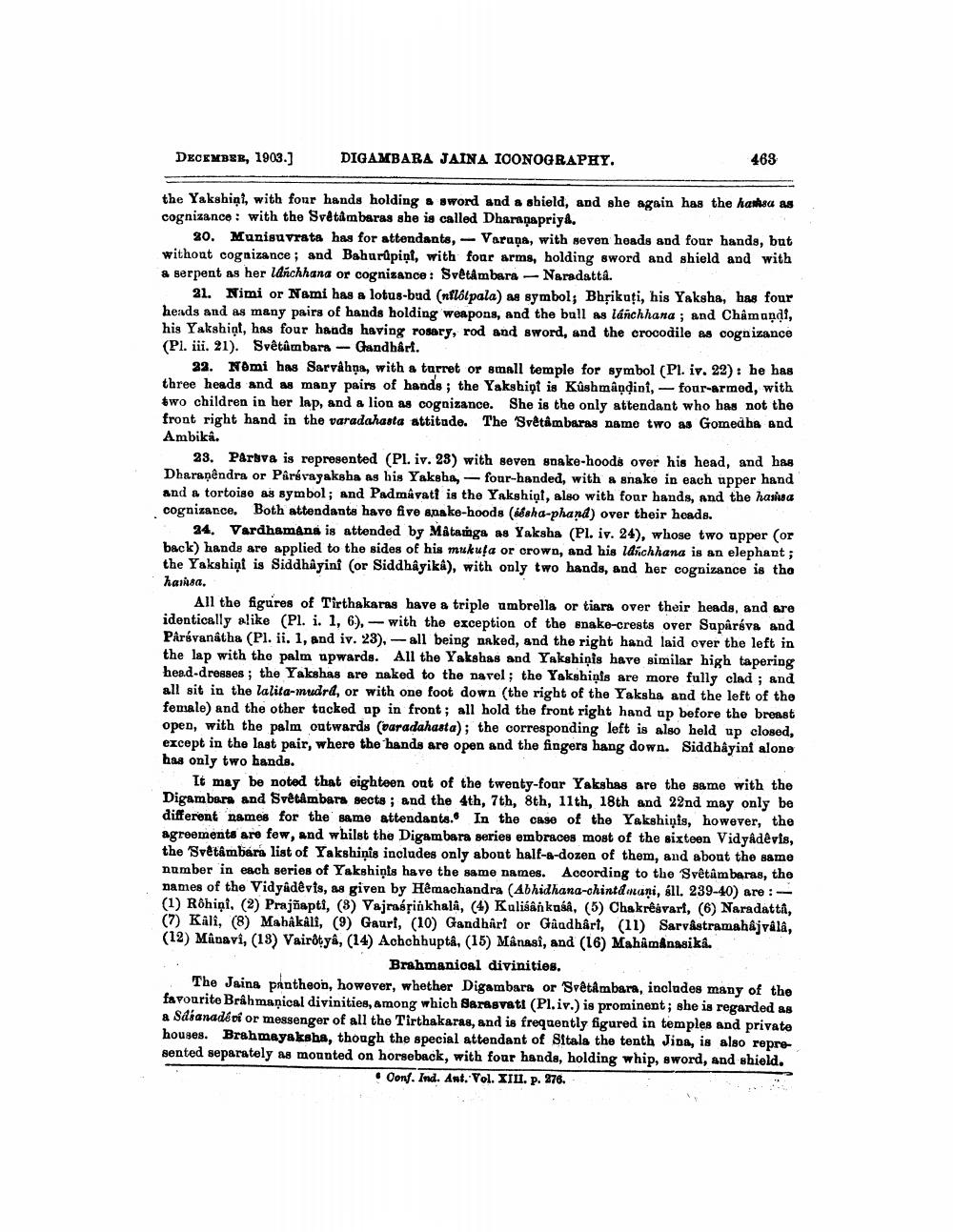________________
DECEMBER, 1903.]
DIGAMBARA JAINA ICONOGRAPHY.
463
the Yakshini, with four hands holding a sword and a shield, and she again has the hashsa as cognizance with the Svêtâmbaras she is called Dharanapriya.
20. Munisuvrata has for attendants, Varana, with seven heads and four hands, but without cognizance; and Bahurûpint, with four arms, holding sword and shield and with a serpent as her lanchhana or cognizance: Svêtâmbara-Naradattâ.
21. Nimi or Nami has a lotus-bud (nflolpala) as symbol; Bhrikuti, his Yaksha, has four heads and as many pairs of hands holding weapons, and the bull as lánchhana; and Chamundi, his Yakshint, has four hands having rosary, rod and sword, and the crocodile as cognizance (Pl. iii. 21). Svêtumbara Gandhârî.
22. Nêmi has Sarvahna, with a turret or small temple for symbol (Pl. iv. 22): he has three heads and as many pairs of hands; the Yakshipt is Kushmandini, four-armed, with two children in her lap, and a lion as cognizance. She is the only attendant who has not the front right hand in the varadahasta attitude. The 'Svêtâmbaras name two as Gomedha and
Ambika.
-
23. Parsva is represented (Pl. iv. 23) with seven snake-hoods over his head, and has Dharapêndra or Pârévayaksha as his Yaksha, four-handed, with a snake in each upper hand and a tortoise as symbol; and Padmavati is the Yakshigt, also with four hands, and the hassa cognizance. Both attendants have five snake-hoods (éésha-phand) over their heads.
24. Vardhamana is attended by Matainga as Yaksha (Pl. iv. 24), whose two upper (or back) hands are applied to the sides of his mukuta or crown, and his lanchhana is an elephant; the Yakshini is Siddhâyinî (or Siddhâyika), with only two hands, and her cognizance is the
haisa.
All the figures of Tirthakaras have a triple umbrella or tiara over their heads, and are identically alike (Pl. i. 1, 6), with the exception of the snake-crests over Supâráva and Pârávanatha (Pl. ii. 1, and iv. 23), all being naked, and the right hand laid over the left in the lap with the palm upwards. All the Yakshas and Yakshinis have similar high tapering head-dresses; the Yakshas are naked to the navel; the Yakshinis are more fully clad; and all sit in the lalita-mudra, or with one foot down (the right of the Yaksha and the left of the female) and the other tucked up in front; all hold the front right hand up before the breast open, with the palm outwards (varadahasta); the corresponding left is also held up closed, except in the last pair, where the hands are open and the fingers hang down. Siddhâyinf alone has only two hands.
It may be noted that eighteen out of the twenty-four Yakshas are the same with the Digambara and Svêtâmbara sects; and the 4th, 7th, 8th, 11th, 18th and 22nd may only be different names for the same attendants. In the case of the Yakshinis, however, the agreements are few, and whilst the Digambara series embraces most of the sixteen Vidyâdêvis, the Svêtâmbara list of Yakshinis includes only about half-a-dozen of them, and about the same number in each series of Yakshipts have the same names. According to the Svêtumbaras, the names of the Vidyâdêvis, as given by Hêmachandra (Abhidhana-chintamani, áll. 239-40) are:(1) Rohini, (2) Prajñapti, (8) Vajraśrinkhalâ, (4) Kulisâñkusâ, (5) Chakrêsvart, (6) Naradattâ, (7) Kali, (8) Mahakali, (9) Gaurt, (10) Gandhart or Gâadhârl, (11) Sarvâstramahâjvâlâ, (12) Mânavi, (18) Vairôtyâ, (14) Achchhuptâ, (15) Mânasi, and (16) Mahamânasika.
Brahmanical divinities.
The Jaina pantheon, however, whether Digambara or Svêtâmbara, includes many of the favourite Brahmanical divinities, among which Sarasvati (Pl. iv.) is prominent; she is regarded as a Sdianadévi or messenger of all the Tirthakaras, and is frequently figured in temples and private houses. Brahmayaksha, though the special attendant of Sitala the tenth Jina, is also represented separately as mounted on horseback, with four hands, holding whip, sword, and shield.
Conf. Ind. Ant. Vol. XIII. p. 276.




